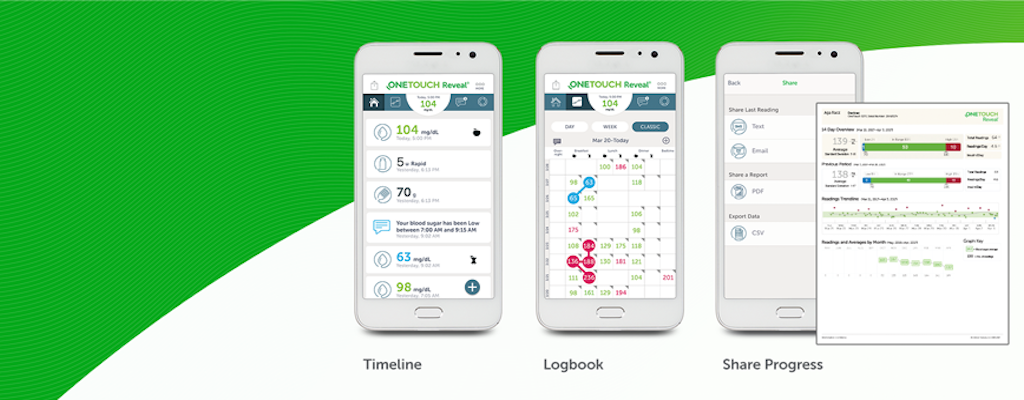T1D Management On The Go: OneTouch Reveal
Earlier this month Johnson and Johnson released the updated version of their popular OneTouch Reveal mobile app, allowing people with type 1 diabetes (T1D) to see their blood sugar levels, connect their actions with trends and share important health data easily with doctors and caregivers.
The rollout essentially represented a ground-up overhaul of the app, which works with the company’s OneTouch Verio Flex Continuous Glucose Monitor (CGM) system. Designers said the update was largely in response to customer feedback, including criticisms, of the prior version.
“We saw an opportunity to change how people with diabetes see their numbers,” said Saleem Ahamed, vice president of Global Franchise Organization at Johnson and Johnson.
Here’s what you need to know about the updated app.
A Home Screen Based on Lifestyle
The app’s home screen is built around an events newsfeed that features customizable reminders, blood sugar averages for time periods (14, 30, or 90 days), a breakdown of pre- and post-meal blood sugar readings and diabetes-related articles.
A new feature, the articles range from medical entries—such as “What is A1C and how is it related to eAG?”—to lifestyle pieces on food and exercise, to stories about medical and scientific developments for diabetes patients.
Primarily sourced from public domain content, Johnson and Johnson has employed an internal team of diabetes educators and physicians to compile relevant stories. As users enter more demographic information, articles will be catered to them. Additionally, users will be able to customize their feed with content that feels most relevant to their needs or interests.
Interface Makeover
The new app features a redesigned interface that gives users multiple ways to view their numbers. The traditional display tells a user what his or her blood glucose level (BGL) is in real time by displaying a number. The Reveal’s recently incorporated visual logbook, however, shows a user his or her numbers in a color-coded range. Under this feature, the number itself is displayed alongside a shaded bar that can quickly alert one to where his or her blood sugar levels are. Low is blue. Green is in a healthy range. And red is high.
The BGL display is organized into a timeline that also includes enterable activity data—what you ate and when, your physical activity throughout the day, any insulin you dosed and when you went to sleep.
“Timelines let you recognize trends,” Ahamed said. “And when you see trends you can start making changes to better manage your numbers. Maybe every time you wake up you notice your blood is low, for instance. That’s helpful data.”
The app itself includes a patterns feature that will analyze your data and alert you to trends as well.
Broader Functionality
Versatility is an ongoing theme in the redesign. Just as the app itself includes multiple visual display options, the data gathered by the app over time can be viewed on multiple platforms, including a web-based site. Users create an account with a specific username and password under which their data is synched. When one logs in to the app or the Web portal, all data is retrievable.
“Different people want different things from diabetes tools,” said Dr. Brian Levy, chief medical officer at Johnson and Johnson and a practicing endocrinologist. “There’s the standard iPhone user who wants quick data. Then there’s the power user who wants to go in to the Web application and drill down through daily numbers by the hour for last two months. It suits both sides and needs.”
Health Date Sharing
A key selling point of any digital system, in addition to the convenience of being able to monitor your diabetes from your phone, is the ease with which medical information can be shared.
The OneTouch Reveal employs an opt-in model around data sharing. This means that patients have to actively choose to participate in data sharing, giving them, in theory, more say over privacy and personal information protection.
Those who do opt-in are given a patient data code they can then share with physicians, family members, caregivers, or any other party they want privy to their medical information. Information is shared via a secure transmission through the OneTouch system.
“In the moment data enhances communication,” said Dr. Levy. “For me it’s so much easier to look online at a patient’s logbook and make sense of their blood glucose versus rattling off numbers over the telephone. When you can see the information it’s much easier to figure out what’s going on.”
In other new developments the app also features a fingerprint log in feature for easy entry into the system.
The new version of the mobile app is available now as a free download for Apple and Android devices in 11 countries globally, including the U.S., Austria, Belgium, Canada, France, Germany, Italy, Ireland, Portugal, Spain and the United Kingdom.






